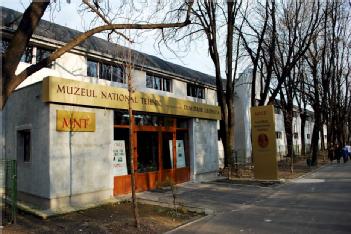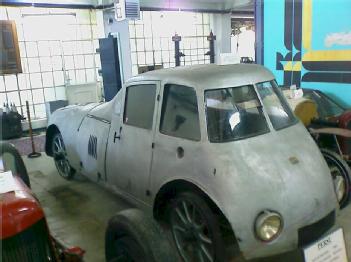
 |
Muzeul Național Tehnic 'Prof. Ing. Dimitrie Leonida' - National Technical Museum Dimitrie Leonida |
040583 Bucureşti, Romania |
|
| Address |
Strada General Candiano Popescu 2 (Parcul Carol I)
Sector 4 |
| Floor area | 4 500 m² / 48 438 ft² |
Museum typ
Exhibition
Technical Museum in general
- Passenger cars
- Steam engines/generators/pumps
- Mining
- Trams
- Air and Space (aviation, spaceflight etc.)
- Combustion engines/generators/pumps
- Electric motors/generators/pumps
- Mills
- Industry / Production Technology
- Tractors
|
Opening times
|
April - October: Wednesday-Sunday: 10:30 - 18:00; November to March: Monday-Friday: 9:30 - 17:00; closed on holidays
aprilie - octombrie: Miercuri-Duminică: 10:30 - 18:00; noiembrie - martie: Miercuri-Duminică: 9:30 - 17.00
|
||||||||
|
Status from 06/2013
|
We don't know the fees. | ||||||||
| Contact |
|
||||||||
| Homepage |
www.mnt-leonida.ro www.cimec.ro/muzee/mteh/mteh.htm |
||||||||
Our page for Muzeul Național Tehnic 'Prof. Ing. Dimitrie Leonida' - National Technical Museum Dimitrie Leonida in Bucureşti, Romania, is not yet administrated by a Radiomuseum.org member. Please write to us about your experience with this museum, for corrections of our data or sending photos by using the Contact Form to the Museum Finder.
| Location / Directions |
The museum is situated on an area of real interest for torists. Here are some of the neighbouring technical monuments: The Filaret railway station, where the first railway from Romanian was inaugurated in 1869; The electric Filaret factory, built between 1906-1908. The building's architecture resembles to that of the Lille buildings, France. It is in the records of the national technical heritage; The artesian well with a zodiac (1934), situated at the entrance of the park, built in the time of Nicolae G. Caranfil, ex-general manager of the Petroleum and Electricity Company; |
|||
| Location / Directions (other) |
Tramvai: 27, 7; autobuz 323 (stația Parcul Carol) | |||
| Description | Wikipedia: World first technical interactive museum. The Romanian Technical Museum was founded in 1909 by Dimitrie Leonida, inspired by Munchen technical museum, visited during his studies in Charlottenburg Politechnic institute. In 1908, with the help of the first promotions of mechanics and electricians from his school, the first in Romania, Leonida has collected first pieces for the museum. What was different in Leonida museum was the educational orientation of the museum and also the interactivity. from http://cimec.ro/muzee/mteh/mteh_eng.htm: The museum's collections:The Technical Museum by the patrimony it shelters, over 5000 exhibits from all the fields of activity, represents the most interesting objectiv in the area.Here are some of the museum's exhibits: The cillinder of the first steam machine, used in the Romanian industry; the machine was brought from Wienn in 1853 to put in motion the oil press and the stones that milled the wheat; Two Brush dynamos (1882) of the first power plant from the country. On the 4th of september 1882 in New York, Thomas Alva Edison, the greatest inventor of all times (1903 patents), put into service the first power plant. It was also in 1882, that in a store house situated on Calea Victoriei, Bucharest, (the present-day location of the University Library), a power plant was put into service. The plant supplied with electricity the arched electrical lamps from the Palace Garden and, by an electrical transport line, the exterior of the National Theatre, the Cismigiu park and the Cotroceni Palace; the Edison dynamo (1884) that supplied the National Theatre. This one was put into service on the 4th of September 1997 on the occasion of the "Thomas Alva Edison - The Light Hommage" exhibition; Electrical tram engine (1894). The tram became functional in Bucharest in 1894 ( and in the world in 1883 - in Austria and England). The museum shelters an engine of the type that had been obtained by Dimitrie Leonida with the help of doctor Constantin Istrate, the one who was responsible for the artrangement of the Carol I park, in his capacity of commissary general of the exhibition (1906); Motor car with Aurel Persu aerodynamic shape, the first one of this type in the world, having the wheels included in the interior of the aerodynamic line. The car was built in 1923 and patented in 1924. The inventor drove over 100,000 kilometres behind its wheel; The "Olds Patent" carriage car (1888), one of the first motor cars that first circulated in Bucharest. It has a spark ignition engine, the steering is actioned through a handle bar and the illuminating is made by acetylene lamps. The Gogu Constantinescu sonic engineGogu Constantinescu created a new science - the science of sound (1916). There is a matematical correspondence between the laws of the sound transmission (transmission of the energy through mecanical vibrations) and the laws of electrical energy transmission;IAR-K 14 plane engine from 1937, at that time considered, due to its technical performances, to be the second in Europe; The model of the Vuia airplane, which on the 18th of March lifted in the air with exclusively own board means, at Montesson - France for the first time in the world; The first individual flying apparatus made and patented by Justin Capra in 1958; The Karpen cells with golden and platinum electrodes, made by Vasilescu Karpen, ex-rector of the Politechnic during 1920-1940; |
| Description (other) |
Text from Wikipedia 5/2012:
Muzeul Tehnic „Prof. Ing. Dimitrie Leonida”, situat în Parcul Carol I, București, creația ilustrului om de știință român, al cărui nume îl poartă, a luat ființă în anul 1909 și a cunoscut substanțiale reorganizări în 1954 și 1972. IstoricDimitrie Leonida a nutrit deosebită grijă pentru popularizarea științei. În 1908 întemeiază prima școală de electricieni și mecanici din România. Cu elevii săi, profesorul Leonida a strâns primele piese care vor constitui nucleul viitorului muzeu. A început prin a achiziționa piese valoroase privind introducerea tehnicii în Bucureștii secolului al XIX-lea :un cilindru din instalația morii cu aburi "Assan" în 1853, dinamurile utilizate pentru iluminarea Cișmigiului, a Palatului regal și a Teatrului Național.Muzeul Național Tehnic din București a fost fondat în 1909 de inginerul Dimitrie Leonida avînd ca model Muzeul Tehnic din München, vizitat de Leonida în perioada studiilor universitare efectuate la Școala Politehnică din Charllotenbourg în apropierea Berlinului. Muzeul a funcționat în primii ani în același sediu cu Școala de Mecanici și Electricieni din strada Mendeleev, apoi într-o clădire din Bulevardul Magheru. Din 1928 Muzeul Tehnic a fost adăpostit într-unui din pavilioanele existente în parcul Carol I, iar din 1935 în actuala clădire care se numea Pavilionul Industrial. DescriereMuzeul beneficiază de o suprafață de expunere de 4.500 m², din care 1.000 m² în aer liber, iar prezentarea exponatelor sale este grupată astfel:istoricul mecanicii, electricitate, magnetism, industria minieră și petrolieră, căldură, telecomunicații, hidraulică, electrotehnică, mașini industriale, transporturi terestre și aeriene, fizică atomică. În muzeu pot fi văzute piese de mare valoare documentară ilustrând spiritul inventiv al poporului român, printre care: moara de apă cu "făcaie" (precursoarea turbinelor Pelton), a cărei construcție este atestată încă din secolul al XV-lea macazul cu ac și inimă de lemn, imaginat pe la 1600 de minerii de la Brad, primul automobil aerodinamic, conceput de inginerul român Aurel Persu, machetele avioanelor cu care Traian Vuia, Aurel Vlaicu și Henri Coandă s-au înscris printre pionierii construcțiilor aerospațiale, diferite utilaje fabricate de uzinele românești. În cadrul muzeului funcționează "Colecția Henri Coandă". Ea evocă prin machete, fotografii și alte genuri de exponate multiplele preocupări ale savantului român Henri Coandă (1886 - 1972), autorul a peste 250 de invenții pentru care a obținut 700 de brevete în diferite țări ale lumii. Dintre machetele aflate în colecție atrag atenția, în special, primul avion cu reacție din lume conceput de Coandă și pilotat de el personal la 16 decembrie 1910, lângă Paris, hidrogeneratorul pentru desalinizarea apei de mare (cu ajutorul energiei solare), sistemul de transport tubular cu mare viteză (o aplicație a "efectului Coandă"), "rezervorul oceanic" destinat petrolului extras din sondele marine, etc. Muzeul dispune, de asemenea, de o bibliotecă de peste 20.000 volume de știință și tehnică (donația inginerului Dimitrie Leonida), ca și de o fototecă cu peste 10.000 imagini. În activitatea muzeului sunt incluse organizări de expoziții tematice, de conferințe, simpozioane, demonstrații și experiențe aplicative. |
Radiomuseum.org presents here one of the many museum pages. We try to bring data for your direct information about all that is relevant. In the list (link above right) you find the complete listing of museums related to "Radio & Co." we have information of. Please help us to be complete and up to date by using the contact form above.
[dsp_museum_detail.cfm]
| Data Compliance | More Information |

 electricaserv.ro
electricaserv.ro 
